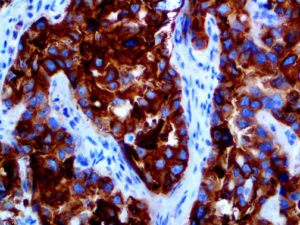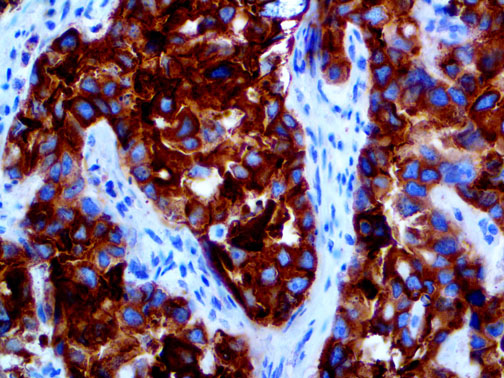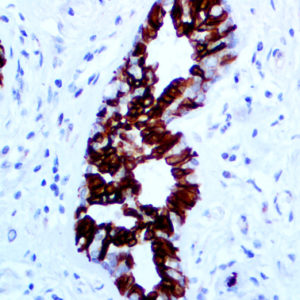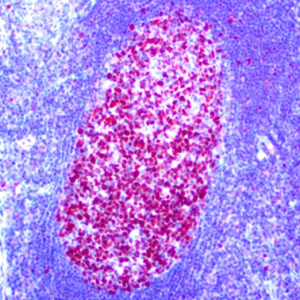
IHC of Glypican-3 on an FFPE Ovarian Carcinoma Tissue
| Intended Use | For In Vitro Diagnostic Use | |||||||||||||||||||||||||||||||||||
| Summary and Explanation | Glypican 3, also known as GPC3, is a human gene. The protein encoded by this gene is a member of the glypican family. Cell surface heparan sulfate proteoglycans are composed of a membrane-associated protein core substituted with a variable number of heparan sulfate chains. Members of the glypican-related integral membrane proteoglycan family (GRIPS) contain a core protein anchored to the cytoplasmic membrane via a glycosyl-phosphatidylinositol linkage. These proteins may play a role in the control of cell division and growth regulation. GPC3 has been identified to be a useful tumor marker for the diagnosis of Hepatocellular Carcinoma (HCC), Hepatoblastoma, Melanoma, Testicular Germ Cell Tumors, and Wilms Tumor. In patients with HCC, GPC3 was overexpressed in neoplastic liver tissue and elevated in serum but was undetectable in normal liver, benign liver, and the serum of healthy donors. GPC3 expression was also found to be higher in HCC liver tissue than in cirrhotic liver or liver with focal lesions such as dysplastic nodules and areas of hepatic adenoma (HA) with malignant transformation. In the context of Testicular Germ Cell Tumors, GPC3 expression is up-regulated in certain histologic subtypes, specifically Yolk Sac Tumors and Choriocarcinoma. A high level of GPC3 expression has also been found in some types of embryonal tumors, such as Wilms Tumor and Hepatoblastoma. | |||||||||||||||||||||||||||||||||||
| Antibody Type | Mouse Monoclonal | Clone | 1G12 | |||||||||||||||||||||||||||||||||
| Isotype | IgG1 | Reactivity | Paraffin, Frozen | |||||||||||||||||||||||||||||||||
| Localization | Cytoplasmic | Control | Melanoma, Hepatoblastoma, Hepatocellular Carcinoma | |||||||||||||||||||||||||||||||||
| Presentation | Glypican-3 is a mouse monoclonal antibody derived from cell culture supernatant that is concentrated, dialyzed, filter sterilized and diluted in buffer pH 7.5, containing BSA and sodium azide as a preservative. | |||||||||||||||||||||||||||||||||||
| Availability |
| |||||||||||||||||||||||||||||||||||
| Note: For concentrated antibodies, please centrifuge prior to use to ensure recovery of all product. | ||||||||||||||||||||||||||||||||||||




